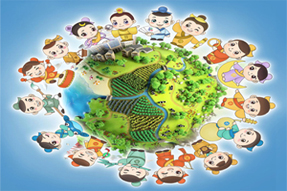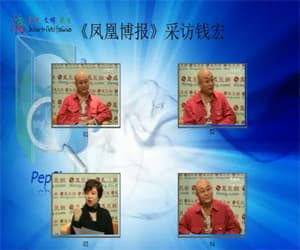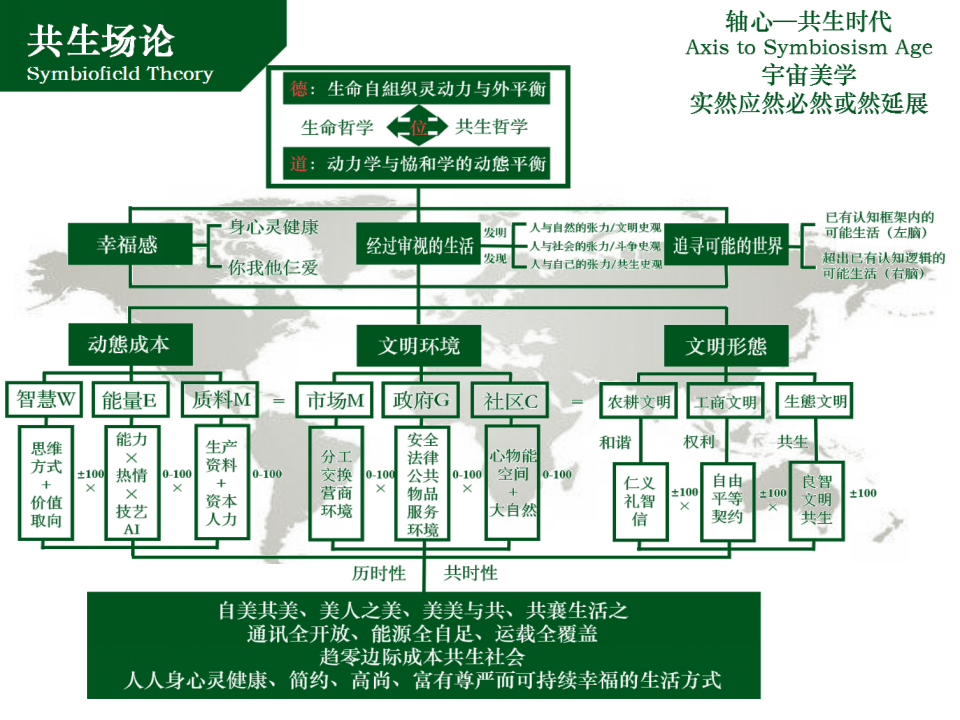New Articles
-
 世界史:生命自组织交互共生的再平衡进程 2025/06/29
世界史:生命自组织交互共生的再平衡进程 2025/06/29世界史:生命自组织交互共生的再平衡进程World History: A Symbiotic Process of Life’s Self-Organizing Balance and Re...
-
 迈向新世界秩序:以社区生态主权取代地缘政治... 2025/06/23
迈向新世界秩序:以社区生态主权取代地缘政治... 2025/06/23Towards a New World Order: Replacing Geopolitical Sovereignty with Community Ecological Sovereignty迈向新世界秩序...
-
 遣返、消化、改变三大策略并举 2025/06/12
遣返、消化、改变三大策略并举 2025/06/12Deportation, Integration, and Transformation: Three Concurrent Strategies to Address Illegal Immigration 解决“非法移...
-
 川普与马斯克的和解空间 2025/06/08
川普与马斯克的和解空间 2025/06/08川普与马斯克的和解空间 Reconciliation Space Between Trump and Musk ——假如把《大而美法案》改为:Slim and B...
共生思想理论前沿
THE THEORY
-

-

-

-
 关于中文“共生”翻译及对应的人、事、物之说明
关于中文“共生”翻译及对应的人、事、物之说明关于中文“共生”翻译及对应的人、事、物之说明 ——Symbiosism:Charles Thomas Taylor &Qian hong又一次量子缠绕...
查看详细说明
Speech
-
 三大自组织货币的共生格局——宏观世界之数字货币 2021/07/08
三大自组织货币的共生格局——宏观世界之数字货币 2021/07/08三大自组织货币的共生格局 ——宏观世界之数字货币 钱 宏 The Institute for Global Symbiosism(...
-
 新汉字yǜ的释义 2019/11/16
新汉字yǜ的释义 2019/11/16语从金音玉(Yǜ):金口玉言,一诺千金,性人诚恳、执信; &n...
-
 钱宏:中国的真实经验与未来走向(凤凰博报专... 2019/11/16
钱宏:中国的真实经验与未来走向(凤凰博报专... 2019/11/16点击播放 中国的真实经验与未来走向《凤凰博报》专访钱宏主持人:...
世界史:生命自组织交互共生的再平衡进程
发布时间:2025/06/29 公司新闻 浏览次数:15
世界史:生命自组织交互共生的再平衡进程
World History: A Symbiotic Process of Life’s Self-Organizing Balance and Rebalancing
钱 宏(Archer Hong Qian)
前 言
旅途笔记:全部历史的第一个前提,无疑是生命自组织连接平衡与再平衡的交互主体共生。世界史,当然就是这样发轫的。先是斯堪的纳维亚半岛维京人发轫,接着伊比利亚、亚平宁、巴尔干三大半岛得天独厚的人们,这里历史形成的国家,分别书写了16世纪之前世界历史,然后上场的才是从尼德兰半岛到英伦岛国开创的近代化进程,然后,法国、德国、苏联先后试图美利坚合众国主导的现代化登场,陆地国家从来都是被书写的,虽然中间夹杂着法国、德国、苏联、中国先后试图扩张陆权世界,但并没有在语言、制度、技术、经济、文化上表现出更多的创新与纠错能力而表现平平且难以持续,那么接下来将如何……
Travel Notes: The first premise of all history is undoubtedly the intersubjective symbiosis of life’s self-organizing connection, balance, and rebalancing. World history, of course, originated in this way. It began with the Vikings of the Scandinavian Peninsula, followed by the uniquely advantaged peoples of the Iberian, Apennine, and Balkan peninsulas, whose nations shaped world history before the 16th century. Then came the modernizing process initiated by the Low Countries and the British Isles. Subsequently, France, Germany, and the Soviet Union successively attempted to join the modernization led by the United States, while land-based nations have always been the subjects written about. Though interspersed with efforts by France, Germany, the Soviet Union, and China to expand a land-power world, they showed little innovation or corrective capacity in language, institutions, technology, economy, or culture, resulting in mediocre and unsustainable outcomes. So, what comes next?
第一节:维京航行者与主体流动的原型
I. The Vikings: Proto-Mobility and Subjectual Awakening
斯堪的纳维亚半岛的维京人是最早打破陆地封闭秩序的“主体流动者”。他们通过远征、贸易、定居,传播语言、货币、文化与技术,开启了欧洲跨区域共生网络的早期雏形,代表了“由静入动”的转型,从地方性向全域网络的主体扩散。
The Vikings of the Scandinavian Peninsula were the earliest “mobile subjects” to break the enclosed order of land-based systems. Through expeditions, trade, and settlement, they spread language, currency, culture, and technology, laying the foundation for an early cross-regional symbiotic network in Europe, marking a shift from stasis to motion and a diffusion of subjects from local to global scales.
第二节:地中海三半岛的共生实践
II. The Three Peninsulas: Mediterranean Symbiotic Civilizations
伊比利亚、亚平宁、巴尔干三大半岛孕育了罗马法、伊斯兰哲学、东正教文明、文艺复兴与大航海。这些文明在冲突中相互学习,在分裂中形成互补,通过平衡信仰、法制、技术与地缘利益,在“再平衡”过程中创造了文艺复兴与航海时代,书写了16世纪之前的世界历史。
The Iberian, Apennine, and Balkan peninsulas gave rise to Roman law, Islamic philosophy, Orthodox Christianity, the Renaissance, and the Age of Exploration. These civilizations learned from each other amid conflicts and complemented one another despite divisions, balancing faith, law, technology, and geopolitical interests to create the Renaissance and the maritime era, shaping world history before the 16th century.
第三节:北海诸岛的制度创新与主体独立
III. The North Sea Isles: Institutional Innovation and Subjectual Independence
尼德兰与英伦岛国的兴起,标志着“去神权化”的文明飞跃。通过议会制、宗教改革与航海金融,它们确立了主体之间的“相对自治”模式,完成了一次信息与治理结构的“再编码”,适应了全球交互密度上升的需求,开启了近代化进程。
The rise of the Low Countries and the British Isles marked a civilizational leap from divine sovereignty to secular autonomy. Through parliamentary systems, religious reforms, and maritime finance, they established a model of “relative autonomy” among subjects, re-encoding information and governance structures to meet the rising density of global interactions, initiating the modern era.
第四节:美利坚的示范型交互主体
IV. America: The Demonstrative Interactive Subject
美国的现代化路径超越了技术领先,确立了“生活方式+治理理念”的全球共生模板。从法治到创新,从个人自由到国家竞争,美国成为全球主体模仿或对抗的参照物,作为首个以“示范性自组织系统”自居的国家,通过制度样板、技术接口与生活方式,诱发他国的“自我模仿”与“协同再平衡”。
The United States’ modernization path went beyond technological leadership, establishing a global symbiotic template of lifestyle and governance ideals. From the rule of law to innovation, from individual freedom to national competition, it became a model for others to emulate or challenge. As the first nation to position itself as a “demonstrative self-organizing system,” it sparked self-imitation and collaborative rebalancing in other countries through institutional models, technological interfaces, and ways of life.
第五节:陆权国家的内向型阻抗
V. Continental Powers: Resistant Systems Struggling for Internal Rebalancing
传统陆权国家(如法国、德国、苏联、中国)由于地理与结构上的“封闭性自组织”模式,早期具备稳定性,但随着全球交互密度升高,其内向型结构难以完成快速再平衡,表现为滞后、焦虑甚至极端反应。尽管试图扩张陆权世界,但它们在语言、制度、技术、经济、文化上缺乏创新与纠错能力,表现平平且难以持续。
Traditional land-based powers (e.g., France, Germany, the Soviet Union, China) adopted a “closed self-organizing” model, offering early stability. However, as global interaction density increased, their inward-looking structures struggled to achieve rapid rebalancing, resulting in lag, anxiety, and even extreme reactions. Despite attempts to expand a land-power world, they lacked innovation and corrective capacity in language, institutions, technology, economy, and culture, leading to mediocre and unsustainable outcomes.
第六节:新北约与《海牙宣言》的集体再平衡
VI. The New NATO and the Hague Declaration: A Collective Rebalancing in Action
2025年《海牙联合宣言》标志着北约的一次“集体再平衡行为”。各国主动承担更多安全支出,不再依附美国,却保持互动系统。这不是解构,而是一次自组织结构的演化升级,体现了交互主体的成熟与平等,迈向多元主体共生的新时代。
The 2025 Hague Joint Declaration marks a “collective rebalancing action” for NATO. Member states have taken on greater security responsibilities, reducing dependence on the U.S. while maintaining an interactive system. This is not a dismantling but an evolutionary upgrade of self-organizing structures, reflecting the maturity and equality of interactive subjects in a multipolar age of symbiosis.
结语:共生的未来与全球化3.0的再平衡
Conclusion: The Future of Symbiosis and Rebalancing in Globalization 3.0
从维京航行者到地中海半岛,再到海洋主导与美利坚的示范,人类历史正逼近一个“多元主体共生”的新时代。未来不再是“谁统治谁”,而是“谁能成为值得共生的对象”,谁能唤醒他者的自组织能力,推动系统进入下一轮再平衡。钱宏教授指出,全球化从2.0(以跨国公司主导的生产网络和互害机制为特征)进入3.0(以技术驱动、区域化和去中心化为特征),需要超越传统的权力主导,转向基于共生哲学的交互网络。“Minds Bank”与“Amorsophia MindsNetworking”正是在这一背景下提出的,旨在通过“共生链”激活全球思想的再平衡(参看《The Simplest Triad of Globalization最简明的全球化三段论》 http://symbiosism.com.cn/9985.html)。这也是“以实力求和平”的深层含义:不是强迫他者屈服,而是激发一个多主体共生的生态系统。那么,接下来将由谁书写这一共生的未来?
From Viking voyages to Mediterranean peninsulas, maritime dominance, and America’s demonstration, human history approaches a multipolar age of symbiosis. The future is no longer about “who rules whom,” but “who can become a worthy co-subject.” It will be determined by those who awaken others’ self-organizing potential and guide the system into the next round of rebalancing. Professor Archer Hong Qian argues that globalization has transitioned from 2.0—characterized by multinational corporate-driven production networks and mutual harm mechanisms—to 3.0, marked by technology-driven, regionalized, and decentralized dynamics, requiring a shift from traditional power dominance to interaction networks based on symbiotic philosophy. “Minds Bank” and “Amorsophia MindsNetworking,” supported by the “Symbiosis Chain,” are proposed in this context to activate global thought rebalancing. This is the deeper meaning of “peace through strength”—not forcing submission, but igniting a multi-subject symbiotic ecosystem. So, who will write the next chapter of this symbiotic future?
Archer Hong Qian
June 28, 2025, Pto to Santiago de Compostela to Porto, Portuorgal-Spain-Portugal

附录:
人类本可和解共生,只需懂一点放弃(特权)的艺术
从新加坡、西班牙、摩洛哥、葡萄牙大街小巷和乡间行走,你会看见不同肤色、语言、衣着、宗教标识的人们,相拥于同一个时空意间的常態。大家相互打招乎,礼让,微笑,做生意,共进晚餐,锻炼身体⋯⋯几乎没有任何阻隔,我不由得想到,在自然生態愛之智慧(调节)下,人们对英国、法国、德国会被外来民族(生育优势、政治特权)吞噬的担忧,也许是多余的或被夸大其词了?
由此,我也不能不想到川普推动的《亚伯拉罕协议》,将可望成为促进民族宗教融合交互主体共生(Intersubjective Symbiosism)的一个范例。
造物主大愛全能,大自然足够慷慨(参考大独裁者里理发师查理最后的感言),生命自组织连接平衡与再平衡真假、善恶、美丑、智愚、圣魔、天堂地狱!
以地中海沿岸各国为例,大部份国家都建设得很美,人们各从其类生活自在,凡事搞不好的国家,特别是本来搞得不错却突然被搞砸了的国家,都是那里发生了一些小问题未能智慧地及时处理好,而被追求特权却以美丽的名义、谎言、话术包装,煽动情绪,得手之后高压➕愚民坚持!
其实,人类所有不能与自然、社会、自我和解共生的阻隔(言行举止和制度),无不来自特权意识及特权阶层操纵政权和垄断资源所致,这也是在阿根廷会出现米莱式纠偏、美国会出现川普式纠偏的原由!
人类没有解不开的结,只要懂一点放弃特权的艺术(如1974葡萄牙康乃馨革命、1975佛朗哥还权于推行民主的西班牙王室),只是有时候确实需要霹雳手段,快刀斩乱麻。
这是共生经济学(Symbionomics)的观察。
2025.6.20晨于
Lisbon the 7 Hotel 101













致纽约市民:
中国两千年历史,从秦汉到当代,反复验证一个残酷的现实:
以“杀富济贫”之名实施高度集权的“大一统”制度,看似替天行道,实则破坏了社会生态与人性发展的根基。
这样的制度不只让生命与自然的自组织力遭到摧毁,更直接瓦解了社会生产与生活之间原本存在的平衡连接。
最终,它会让城市、社区、社会、国家,乃至个人,都丧失创新与纠偏的勇气、智慧和能力。
社会陷入犬儒、内卷与争权夺利的恶性循环,只剩“流氓轮流坐庄”,而非真正的人民自治与多元共存。
人类不该再重复这样的悲剧。
⸻
To the People of New York:
Over 2,000 years of Chinese history—from the Qin and Han dynasties to today—repeatedly prove one harsh truth:
Any regime built on centralized control, even when justified as “redistributing wealth” or creating unity, ultimately destroys the self-organizing power of life, nature, and society.
It doesn’t just stifle individual freedoms—it erodes the courage, wisdom, and capacity for innovation and self-correction at every level: from individuals and cities, to communities, societies, and entire nations.
The result is a cycle of cynicism, privilege-chasing, and “rotating thugs in power,” where true diversity, cooperation, and human dignity are lost.
We must learn from history—not repeat it.
2025年06月29日下午1:43
怎么办?从自然到社会、从个人到国家,八个字:各从其类,交互共生。或:存同尊异,间道共生!
2025年06月29日下午1:54